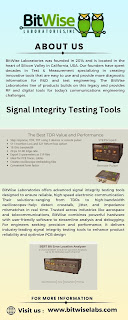The Importance of Test Insertion Loss in High-Frequency Systems
Insertion
loss refers to the amount of signal power lost when a device or
component is inserted into a transmission line or system. This loss can occur
in various passive components, including cables, connectors, filters, or other
transmission media. It is typically measured in decibels (dB) and reflects the
efficiency with which a signal can pass through a specific component without
excessive attenuation.
In simpler terms, insertion loss is the reduction in signal strength as it
passes through a device. Lower insertion loss values indicate better
performance, as less signal is being lost during transmission.
When it comes to ensuring the performance and efficiency of electronic systems,
one of the most important factors to consider is signal integrity. In complex
networks and communication systems, the signal must pass through various
components such as cables, connectors, and circuit boards. As the signal
travels, it can weaken due to various factors, leading to signal degradation or
loss. This is where the concept of insertion loss becomes critical,
especially for engineers and technicians working in high-frequency and RF
applications.
Bitwise
Laboratories offers advanced testing solutions to measure and
evaluate insertion loss, ensuring optimal system performance and design
efficiency. In this guide, we will explore the key aspects of Test Insertion Loss, why it
matters, and how we provide accurate testing services to improve
electronic and communication systems.
Why is Insertion Loss Important?
1. Signal
Quality: Insertion loss directly impacts the quality of signals
transmitted through a system. A high insertion loss may result in poor signal
integrity, leading to data errors, noise, or even signal failure in extreme
cases.
2. System
Efficiency: Minimizing insertion loss helps improve the overall
efficiency of electronic and communication systems. Whether you're working with
RF circuits, data transmission networks, or fiber optics, reduced signal loss
translates to better performance.
3. Component Optimization: Testing insertion loss is crucial during the design and manufacturing process to ensure components such as cables, connectors, or circuit boards perform as expected. This ensures that the final product meets industry standards and delivers optimal results.
Factors That Affect Insertion Loss
Several factors contribute to insertion loss in electrical and RF systems:
·
Material Properties: The
materials used in components, such as cables and connectors, significantly
impact insertion loss. Conductive materials, dielectric losses, and surface
roughness can all contribute to signal attenuation.
·
Frequency: Insertion loss tends
to increase with higher frequencies. Therefore, components designed for
high-frequency applications, such as RF or microwave systems, require precise
testing to ensure minimal signal loss.
·
Length of Transmission Line:
The longer the transmission line (e.g., a cable or circuit trace), the greater
the insertion loss. This is because the signal is subject to more resistance
and potential interference over a longer distance.
·
Impedance Matching: Improper
impedance matching between components can lead to signal reflections,
increasing insertion loss. Ensuring a proper impedance match reduces signal
degradation and enhances system performance.
Here are the key features and steps
involved in Test Insertion Loss at Bitwise Laboratories:
1. Accurate Measurement
Bitwise Laboratories uses industry-leading equipment to accurately measure
insertion loss in components and systems. By applying precise test signals,
their team of experts can identify how much signal power is lost as it passes
through the test component. The results are measured in decibels (dB), giving a
clear indication of the component’s performance.
2. Frequency Sweep
To ensure comprehensive testing, Bitwise Laboratories performs frequency
sweeps during insertion loss tests. This means that the test signal is
transmitted across a range of frequencies to evaluate how the component behaves
at different levels. Insertion loss can vary significantly depending on the
frequency, especially in high-frequency applications. The frequency sweep helps
engineers understand the component's performance over its entire operational
bandwidth.
3. Component and System
Evaluation
Whether it’s an individual component like a cable or connector, or a more
complex system like a circuit board, Bitwise Laboratories can test and
evaluate insertion loss in various configurations. This versatility makes it
possible to diagnose signal integrity issues at multiple levels in the system.
4. Customized Testing Solutions
Different projects require different testing parameters. Bitwise
Laboratories tailors its insertion loss testing to meet the specific needs of each client. Whether you need
high-frequency RF testing or evaluations in data transmission systems, their
team will customize the testing protocol to provide the most accurate and
relevant data.
5. Comprehensive Reporting
After conducting the test insertion
loss, Bitwise Laboratories provides clients with detailed
reports that include all necessary measurements, analysis, and conclusions.
These reports help engineers and designers understand the component’s
performance, make informed decisions, and optimize the system for better signal
integrity.
Benefits of Insertion Loss Testing at Bitwise Laboratories
1. Improved
System Performance: By accurately measuring insertion loss, Bitwise Laboratories
helps clients enhance the performance of their systems by identifying weak
points and offering solutions to reduce signal degradation.
2. Reliable
Data: The use of advanced equipment and precise testing methodologies
ensures that clients receive accurate and reliable data to make informed design
and engineering decisions.
3. Custom
Solutions: We tailors its testing services to meet the unique needs
of each client, ensuring that the testing process is relevant and valuable to
the project at hand.
4. Experienced
Team: With years of experience in the industry, the team at Bitwise Laboratories provides expert guidance, helping
clients understand the importance of insertion loss and how to mitigate its
effects.
Conclusion
Testing insertion loss is an essential part of ensuring signal integrity and
system efficiency, especially in high-frequency and RF applications. Bitwise Laboratories
offers advanced test insertion loss
solutions that provide accurate, reliable data to help
engineers and designers optimize their components and systems. With customized
testing protocols, frequency sweeps, and comprehensive reporting, Bitwise
Laboratories is a trusted partner for ensuring optimal performance in today’s
complex electronic and communication systems.
For More Information
Visit us : www.bitwiselabs.com .




Comments
Post a Comment